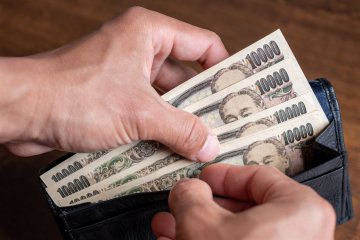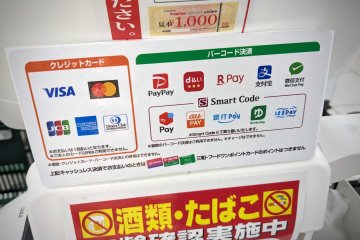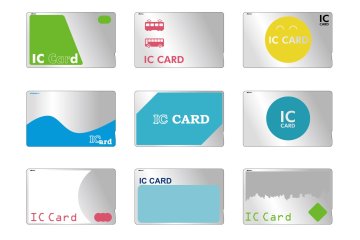When traveling in Japan, visitors will need to use the Japanese currency. In our Japan money guide, we outline the basics of using Japanese yen (¥, JPY), including denominations, exchange rates, and payment methods.
Table of contents
Japanese Currency – the Yen
The official Japanese currency is the Japanese yen, represented by the currency code JPY and the currency symbol, ¥.
Locally in Japan, yen is pronounced “en” in Japanese and often accompanied by its kanji, 円, in everyday use.
Japanese yen is available in 10 denominations, including six coins and four banknotes that you can read about in-depth in the denomination section.
How to Pay

As of 2025, the number of ways to pay with in Japan has grown considerably. Though cash is arguably still king, code-based and cashless payment is now increasingly widespread.
Cash
Despite the widening use of credit- and debit cards, Japan is still predominantly considered a cash-based society which especially holds true in rural areas or when visiting small, independent businesses.
-
It’s always a good idea to have small denominations (10 yen and 100 yen coins, as well as 1,000 yen notes) handy, as many ticket and vending machines will not accept larger denominations (especially 5,000 and 10,000 yen bills).
-
Having so much cash in your wallet may make you feel uneasy at first, but Japan does have one of the lowest crime rates in the world. While nothing beats being careful, chances are you’re more likely to lose money by dropping or leaving it, rather than it getting stolen.
- If you are holding too many coins, note that a lot of supermarkets or convenience stores (7-eleven, Family Mart, Lawson etc) have payment kiosks that let you use denominations down to 1 yen allowing you to quickly deposit them.
Credit/Debit Cards
Credit and debit cards are increasingly accepted across Japan, but always try to check in advance whether a place solely accepts credit cards (also often indicated near the shopfront for any business), as well as abide by these tips:
-
Even if you decide to mainly use a credit card, it is still recommended to carry or have access to sufficient cash.
-
Most credit card companies will charge a surcharge (usually 1–3%) for foreign-issued cards. A Wise card lets you avoid foreign transaction fees and convert at the real exchange rate, even when using local ATMs.
-
The most commonly accepted cards are MasterCard, Visa, and JCB, followed by American Express and Diner’s Club.
- Credit card readers typically support one of swipe, insert or tap/contactless (referred to as "touch" in Japan). In some cases, you may still asked to sign for payments but it is rare for the vendor to check the authenticity of this (often they'll have already returned the card).
Wise in Japan
If you need convenient access to currency during your trip, Wise allows you to do so — economically, quickly and easily.
Together with the app, a Wise card can help give you more spending flexibility in Japan while always knowing you'll get competitive exchange rates and the ability to set currency alerts or auto-convert currency.
IC Travel Cards

Transit IC cards, such as Suica and PASMO, are commonplace in Japan's major cities. The 10 main IC operators across Japan also include Icoca, Pitapa, Toica, Manaca, Kitaca, Suogca, Nimoca and Hayakaken. They are all interoperable, meaning you can use one card of another IC card's network, but you cannot travel between IC card areas on a single card.
They are predominantly used for train and bus fares, but can also be used for payments in urban areas, including for use at vending machines, station kiosks, shops, cafes and restaurants.
Both iPhone and Android offer digital versions of Suica and Pasmo via their official apps (Mobile Suica and Mobile Pasmo) for easy contactless payment. Android devices need to support Osaifu-Keitai/FeliCa (only installed on phones sold within Japan) whereas Apple devices including iPhone 8 or later and Apple Watch Series 3 or later should work fine.
Digital Payments
If you have a Japanese phone number and residency, a number of local payment apps are also available to you. Digital payment apps can typically be topped up at ATMs or via connecting a bank account, credit card or mobile service provider (carrier billing). Payments can be made via contactless terminals, scanning a vendor's QR code (usually on a sticker or sign) or having a vendor scan your in-app QR code. Example services include PayPay, MerPay (by Mercari) and Rakuten Pay.
Getting Yen in Japan
ATMs
Like with any currency, if you need access to cash then local ATMs can help:
-
Japan Post ATMs are located at more than 26,000 locations nationwide (denoted with the “JP” logo); each post office will have at least one, while they can also be found at shopping malls and supermarkets. Service hours vary according to location; large post offices in major cities will have longer hours than small ones in rural areas. English services are also available
-
7-Eleven (Seven Bank) has over 20,000 ATMs across Japan, located at 7-Eleven convenience stores. Services are offered virtually 24/7 and currently available in 12 languages (Japanese, English, Korean, Simplified Chinese, Portuguese, Chinese traditional, Thai, Malay, Indonesian, Vietnamese, French, and German).
-
E-net ATMs in Family Mart can also offer a service to international cards including MasterCard.
-
Be aware of service charge fees that may also rise for transactions made outside traditional operating hours (usually 9am–5pm on weekdays):
Exchanging Currencies
For a general idea of what current exchange rates are like, check out XE Currency Converter or Wise's own Currency Converter.
All vendors with an “Authorized Foreign Exchange” sign can exchange currencies; these include banks and money changers (such as Travelex), often located at airports and in major cities.
- Banks are usually open from 9am to 3pm on weekdays.
-
Hotels and large department stores may offer currency exchange services, although with extra fees and less favorable rates.
Traveler's Checks
-
Due to the relatively limited number of ATMs that support foreign-issued cards, traveler’s checks are more useful than you’d think in Japan.
-
Traveler's checks tend to carry more favorable rates than money changers and ATMs, and are accepted by leading banks, hotels, ryokan, and stores in major cities, but very few places elsewhere.
- Do not pay with a check drawn from a foreign bank; as many Japanese places will either charge large extra fees or not accept them at all.
Money Etiquette and Things to Know
Consider the following hints and tips when using money in Japan:
-
Tipping: Japan has a no-tip policy. Leaving a tip at a restaurant or a taxi driver will often result in them returning you the money (If you do want to leave a tip—such as for a maid at a ryokan or a tour guide—put the money in an envelope and give it to them in person).
-
Handling cash: Most restaurants, shops, and even taxis, will provide a small tray for you to put money on, instead of giving it directly to the cashier. This is also often used when receiving small change.
-
Consumption tax: When paying for goods in Japan, it is fairly common to see the pre-tax price advertised although, by law, the final price should always be indicated. Consumption tax is currently 10%, but for cafes, restaurants or other businesses serving food to take away the tax is 8%.
-
When to exchange: Although it depends on the currency, it is generally better to exchange yen in Japan than in your home country, due to a lower commission and better exchange rate. Similarly, you'll typically get better rates away from the major airports.
Denominations
Read more in detail about each of the Japanese yen's coins and bills – hover on the image to see the reverse detail!
Japan's Coins
| Coin | Details |
|---|---|
| 1 yen (ichi-en)   |
|
| 5 yen (go-en)   |
|
| 10 yen (jū-en)   |
|
| 50 yen (gojū-en)   |
|
| 100 yen (hyaku-en)   |
|
| 500 yen (gohyaku-en)   |
|
Japan's Banknotes
Japan's banknotes were redesigned and newly issued in 2024 but the older notes will remain legal tender. Here's a comparison view of what's what:
| Banknote | Details |
|---|---|
| 1000 yen (sen-en)   |
|
| 2000 yen (ni-sen-en)   |
|
| 5000 yen (go-sen-en)   |
|
| 10,000 yen (ichi-man-en)   |
|











